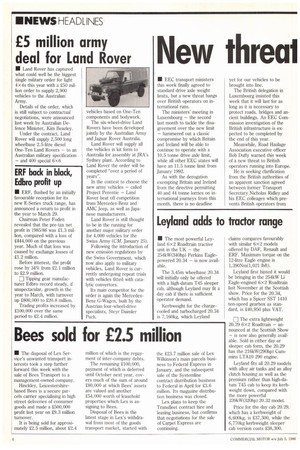New threai
Page 6

Page 7

If you've noticed an error in this article please click here to report it so we can fix it.
3s axle limit is agreed
• EEC transport ministers this week finally agreed to standard drive axle weight limits, but a new threat hangs over British operators on international runs.
The ministers' meeting in Luxembourg — the second last month to tackle the disagreement over the new limit — hammered out a classic compromise by which Britain and Ireland will be able to continue to operate with a 10.5 tonne drive axle limit, while all other EEC states will have an 11.5 tonne limit from January 1992.
As with the derogation exempting Britain and Ireland from the directive permitting 40 and 44 tonne lorries on international journeys from this month, there is no deadline yet for our vehicles to be brought into line.
The British delegation in Luxembourg insisted this week that it will last for as long as it is necessary to protect roads, bridges and ancient buildings. An EEC Commission investigation of the British infrastructure is expected to be completed by the end of this year.
Meanwhile, Road Haulage Association executive officer Bob Duffy warned this week of a new threat to British operators running into Europe.
He is seeking clarification from the British authorities of an apparent sanction agreed between former Transport Secretary Nicholas Ridley and his EEC colleages which prevents British operators from running at over 38 tonnes anywhere in the EEC.
"We want a statement from Transport Secretary John Moore justifying why the Government is sacrificing the British international haulier. We are not amused," Duffy told CM.
While it was always understood that opeators could not run at over 38 tonnes within Britain or Ireland, Duffy said it has only now become clear that other states will be empowered to stop our vehicles from running at that weight on the European mainland.
Freight Transport Association planning director Richard Turner said after Monday's meeting: "We view with great regret rather than anger the British decision to stay out of line. We recognise that it is in a difficult position."
He said the decision to go for an EEC axle weight limit substantially higher than 10.5 tonnes will cause heartache to British bridge engineers, but said much of the problem rests with poor maintenance of bridges in the past and that, in any case, most bridges will be capable of carrying the heavier vehicles.
Turner added that industry will pay for the infrastructure it uses in the future and will foot the bill incurred by an 11.5 tonne axle.
This week's meeting also sanctioned a substantial increase in the community quota system which still covers only about 10% of all cross-frontier journeys. This move has been welcomed by most British observers.
Starting in 1987, it has been agreed that the community permits (which numbered 7,437 this year) will increase by 40% on a compound basis each year.
By 1992, all bilateral permits will be scrapped and their places taken by the community permits which by then should account for 90% of cross-frontier journeys.
"After many years of argument the breakthrough has come at last," said Stanley Clinton Davis, the EEC's Transport Commissioner after the meeting.
"The fights are now set at green for the creation of a genuine EEC transport market in 1992."
The EEC estimates that at present the quota of 7,437 permits covers 10% of trans frontier journeys.
This is due to a rise to 56,000 licences by 1992 which will then cover about 75% of trade.
• A delegation from the CBI last week met with the European Commission to press for the swift introduction of free trade within the EEC.
The CBI is concerned that the progress towards market liberalisation is being delayed by slow decision making, and fears that it will not be possible to introduce free trade within Europe in 1992 as scheduled.




































































































